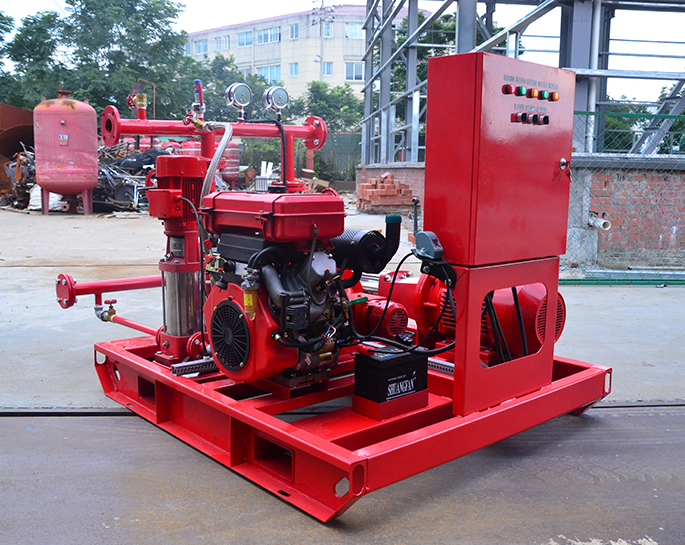How do environmental sustainability considerations influence the design and operation of fire pump systems?
Apr 18, 2024
Share:
Environmental sustainability considerations can significantly influence the design and operation of fire pump systems in several ways:
1. **Energy Efficiency**: Fire pump systems typically require significant energy to operate, especially during emergencies. Designing pumps that are energy-efficient reduces the environmental impact by lowering electricity consumption. Variable frequency drives (VFDs) can be incorporated to adjust pump speed according to demand, saving energy during non-emergency periods.
2. **Material Selection**: Choosing environmentally friendly materials for construction reduces the ecological footprint of fire pump systems. This includes selecting materials with lower embodied energy, recyclable components, and those free from harmful chemicals or pollutants.
3. **Water Conservation**: Fire pump systems often rely on large volumes of water. Implementing water conservation measures, such as rainwater harvesting, graywater reuse, or using water-efficient nozzles and sprinklers, minimizes water consumption and reduces strain on local water resources.
4. **Emissions Reduction**: Combustion engines used to power fire pumps can emit pollutants and greenhouse gases. Opting for cleaner-burning fuels, like natural gas or biodiesel, or transitioning to electric-powered pumps can reduce emissions and improve air quality.
5. **Maintenance and Lifecycle Management**: Proper maintenance practices prolong the lifespan of fire pump systems, reducing the frequency of replacements and associated environmental impacts. Implementing predictive maintenance techniques can help anticipate and prevent equipment failures, minimizing resource waste.
6. **Waste Management**: Proper disposal of firefighting foam and other chemicals used in fire suppression is crucial to prevent environmental contamination. Implementing strategies for safe handling, storage, and disposal of these materials ensures compliance with environmental regulations and reduces the risk of pollution.
7. **Resilience and Adaptation**: Designing fire pump systems with resilience in mind, such as incorporating backup power sources or redundant systems, ensures continued operation during natural disasters or other emergencies, ultimately contributing to community resilience and sustainability.
Incorporating these environmental sustainability considerations into the design and operation of fire pump systems not only minimizes their ecological footprint but also enhances their effectiveness and resilience in protecting lives and property.

1. **Energy Efficiency**: Fire pump systems typically require significant energy to operate, especially during emergencies. Designing pumps that are energy-efficient reduces the environmental impact by lowering electricity consumption. Variable frequency drives (VFDs) can be incorporated to adjust pump speed according to demand, saving energy during non-emergency periods.
2. **Material Selection**: Choosing environmentally friendly materials for construction reduces the ecological footprint of fire pump systems. This includes selecting materials with lower embodied energy, recyclable components, and those free from harmful chemicals or pollutants.
3. **Water Conservation**: Fire pump systems often rely on large volumes of water. Implementing water conservation measures, such as rainwater harvesting, graywater reuse, or using water-efficient nozzles and sprinklers, minimizes water consumption and reduces strain on local water resources.
4. **Emissions Reduction**: Combustion engines used to power fire pumps can emit pollutants and greenhouse gases. Opting for cleaner-burning fuels, like natural gas or biodiesel, or transitioning to electric-powered pumps can reduce emissions and improve air quality.
5. **Maintenance and Lifecycle Management**: Proper maintenance practices prolong the lifespan of fire pump systems, reducing the frequency of replacements and associated environmental impacts. Implementing predictive maintenance techniques can help anticipate and prevent equipment failures, minimizing resource waste.
6. **Waste Management**: Proper disposal of firefighting foam and other chemicals used in fire suppression is crucial to prevent environmental contamination. Implementing strategies for safe handling, storage, and disposal of these materials ensures compliance with environmental regulations and reduces the risk of pollution.
7. **Resilience and Adaptation**: Designing fire pump systems with resilience in mind, such as incorporating backup power sources or redundant systems, ensures continued operation during natural disasters or other emergencies, ultimately contributing to community resilience and sustainability.
Incorporating these environmental sustainability considerations into the design and operation of fire pump systems not only minimizes their ecological footprint but also enhances their effectiveness and resilience in protecting lives and property.


.png)
.png)

.png)


